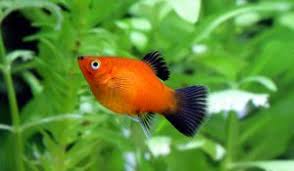
Platy Fish
Conditions of detention
Platies thrive in a well-maintained aquarium with a minimum of 10 gallons, though larger tanks are preferable for groups. They prefer slightly alkaline water with a pH of 7.0 to 8.3 and a temperature range of 70-80°F (21-27°C). Platies are adaptable and can tolerate a variety of water conditions, but they do best in clean, well-filtered water with some hardness. A well-planted tank with plenty of swimming space and hiding spots is ideal.
Useful Fact: Platies are highly adaptable and can live in both freshwater and slightly brackish water environments, making them versatile for different tank setups.
Nutrition and diet
Platies are omnivorous and require a varied diet. They do well on high-quality flake or pellet food, supplemented with fresh vegetables like spinach, peas, and zucchini, as well as live or frozen foods such as brine shrimp, daphnia, and bloodworms.
Useful Fact: Platies have a particular fondness for algae and vegetable matter, so including plant-based foods in their diet is essential for their health.
Health
Platies are generally hardy but can be susceptible to common freshwater fish diseases such as ich, fin rot, and internal parasites, especially if water quality is poor. Stress from overcrowding, sudden changes in water conditions, or aggressive tankmates can also lead to health issues.
Useful Fact: Regular water changes and maintaining stable water conditions are key to preventing disease in Platies.
Grooming and care
Platies do not require traditional grooming, but their environment needs to be kept clean. Regular water changes, monitoring water parameters, and maintaining a clean tank are essential to their care.
Useful Fact: Platies are prolific breeders, so if you do not wish to manage a large number of fry, consider keeping only one gender or providing ample hiding spots for fry to be eaten by other tank inhabitants.
Education and training
Platies are not typically trained, but they can learn to recognize their owners and may come to the surface during feeding times. They are curious and can be conditioned to respond to specific cues, such as tapping the tank gently.
Useful Fact: Platies are active swimmers and enjoy exploring their environment, making them engaging and interactive fish to observe.
Toys and entertainment
Platies enjoy exploring their environment, so providing them with live plants, rocks, and decorations gives them plenty of places to explore and hide. They also benefit from having open swimming areas.
Useful Fact: Live plants not only enhance the tank’s appearance but also provide Platies with natural grazing spots and hiding places, which reduce stress.
Safety
Platies are peaceful fish and do well in community tanks with other small, non-aggressive species. However, they should not be housed with aggressive or fin-nipping fish, as this can lead to stress and injury. It’s important to avoid overcrowding, as this can lead to increased aggression and health issues.
Useful Fact: Keeping Platies in a ratio of one male to two or three females can help reduce stress and aggression, particularly during breeding.
Accessories
Essential accessories for a Platy tank include a reliable filter, a heater to maintain a stable temperature, and a light source that supports plant growth. Plants, both live and artificial, provide hiding spots and reduce stress.
Useful Fact: Platies appreciate a tank with plenty of vegetation and open swimming areas, which mimic their natural habitat and promote healthy behavior.
Socialization
Platies are social and do best in groups. They are generally peaceful and get along well with other community fish of similar size and temperament. It’s best to keep them in groups of at least five to six to ensure they feel secure.
Useful Fact: Platies are livebearers, meaning they give birth to live young, so if males and females are kept together, be prepared for frequent births.
Travel and Transportation
When transporting Platies, use a plastic bag filled with water from their tank and ensure it is well-oxygenated. Transport them carefully to avoid temperature fluctuations and stress. Keep the bag in a dark, insulated container to minimize stress.
Useful Fact: To minimize stress during transport, ensure the water in the transport bag is similar in temperature and parameters to their home tank.
Behavior and psychology
Platies are active, peaceful, and social fish. They enjoy swimming in the middle and upper levels of the tank and are constantly exploring their surroundings. They can be slightly territorial, especially males, but this behavior is generally mild.
Useful Fact: Platies are known for their lively behavior and can be very active, making them an engaging addition to community tanks.
Legal aspects
There are generally no legal restrictions on owning Platies, but it’s important to ensure they are sourced from reputable breeders or suppliers. Additionally, because Platies can breed prolifically, it’s important to manage their population responsibly to avoid overstocking your tank.
Useful Fact: If you don’t want to breed Platies, consider keeping only one gender or maintaining a single-sex group to prevent overpopulation.


